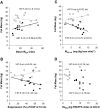Abdominal obesity in older women: potential role for disrupted fatty acid reesterification in insulin resistance
- PMID: 18198225
- PMCID: PMC2291490
- DOI: 10.1210/jc.2007-1875
Abdominal obesity in older women: potential role for disrupted fatty acid reesterification in insulin resistance
Abstract
Context: Excess abdominal adiposity is a primary factor for insulin resistance in older age.
Objectives: Our objectives were to examine the role of abdominal obesity on adipose tissue, hepatic, and peripheral insulin resistance in aging, and to examine impaired free fatty acid metabolism as a mechanism in these relations.
Design: This was a cross-sectional study.
Setting: The study was performed at a General Clinical Research Center.
Participants: Healthy, inactive older (>60 yr) women (n = 25) who were not on hormone replacement therapy or glucose-lowering medication were included in the study. Women with abdominal circumference values above the median (>97.5 cm) were considered abdominally obese.
Main outcome measures: Whole-body peripheral glucose utilization, adipose tissue lipolysis, and hepatic glucose production were measured using in vivo techniques according to a priori hypotheses.
Results: In the simple analysis, glucose utilization at the 40 mU insulin dose (6.3 +/- 2.8 vs. 9.1 +/- 3.4; P < 0.05), the index of the insulin resistance of basal hepatic glucose production (23.6 +/- 13.0 vs. 15.1 +/- 6.0; P < 0.05), and insulin-stimulated suppression of lipolysis (35 vs. 54%; P < 0.05) were significantly different between women with and without abdominal obesity, respectively. Using the glycerol appearance rate to free fatty acid ratio as an index of fatty acid reesterification revealed markedly blunted reesterification in the women with abdominal adiposity under all conditions: basal (0.95 +/- 0.29 vs. 1.35 +/- 0.47; P < 0.02); low- (2.58 +/- 2.76 vs. 6.95 +/- 5.56; P < 0.02); and high-dose (4.46 +/- 3.70 vs. 12.22 +/- 7.13; P < 0.01) hyperinsulinemia. Importantly, fatty acid reesterification was significantly (P < 0.01) associated with abdominal circumference and hepatic and peripheral insulin resistance, regardless of total body fat.
Conclusion: These findings support the premise of dysregulated fatty acid reesterification with abdominal obesity as a pathophysiological link to perturbed glucose metabolism across multiple tissues in aging.
Figures



Similar articles
-
Adipose tissue sensitization to insulin induced by troglitazone and MEDICA 16 in obese Zucker rats in vivo.Am J Physiol Endocrinol Metab. 2003 Apr;284(4):E795-803. doi: 10.1152/ajpendo.00368.2002. Epub 2002 Dec 17. Am J Physiol Endocrinol Metab. 2003. PMID: 12488241
-
Impaired insulin-mediated antilipolysis and lactate release in adipose tissue of upper-body obese women.Obesity (Silver Spring). 2012 Jan;20(1):57-64. doi: 10.1038/oby.2011.290. Epub 2011 Sep 29. Obesity (Silver Spring). 2012. PMID: 21959346
-
Mesenteric Fat Lipolysis Mediates Obesity-Associated Hepatic Steatosis and Insulin Resistance.Diabetes. 2016 Jan;65(1):140-8. doi: 10.2337/db15-0941. Epub 2015 Sep 17. Diabetes. 2016. PMID: 26384383
-
Basic disturbances in skeletal muscle fatty acid metabolism in obesity and type 2 diabetes mellitus.Proc Nutr Soc. 2004 May;63(2):323-30. doi: 10.1079/PNS2004361. Proc Nutr Soc. 2004. PMID: 15294050 Review.
-
In vivo regulation of lipolysis in humans.J Lipid Res. 1994 Feb;35(2):177-93. J Lipid Res. 1994. PMID: 8169522 Review.
Cited by
-
Bed rest worsens impairments in fat and glucose metabolism in older, overweight adults.J Gerontol A Biol Sci Med Sci. 2014 Mar;69(3):363-70. doi: 10.1093/gerona/glt100. Epub 2013 Jul 31. J Gerontol A Biol Sci Med Sci. 2014. PMID: 23902932 Free PMC article.
-
Aging adipose tissue, insulin resistance, and type 2 diabetes.Biogerontology. 2024 Feb;25(1):53-69. doi: 10.1007/s10522-023-10067-6. Epub 2023 Sep 19. Biogerontology. 2024. PMID: 37725294 Review.
-
Metabolic dysfunction in obesity is related to impaired suppression of fatty acid release from adipose tissue by insulin.Obesity (Silver Spring). 2023 May;31(5):1347-1361. doi: 10.1002/oby.23734. Epub 2023 Mar 29. Obesity (Silver Spring). 2023. PMID: 36988872 Free PMC article.
-
Twelve weeks of endurance training increases FFA mobilization and reesterification in postmenopausal women.J Appl Physiol (1985). 2010 Dec;109(6):1573-81. doi: 10.1152/japplphysiol.00116.2010. Epub 2010 Jul 22. J Appl Physiol (1985). 2010. PMID: 20651217 Free PMC article. Clinical Trial.
-
Impaired suppression of fatty acid release by insulin is a strong predictor of reduced whole-body insulin-mediated glucose uptake and skeletal muscle insulin receptor activation.Acta Physiol (Oxf). 2025 Jan;241(1):e14249. doi: 10.1111/apha.14249. Epub 2024 Nov 1. Acta Physiol (Oxf). 2025. PMID: 39487600 Free PMC article.
References
-
- Bjorntorp P 1996 The regulation of adipose tissue distribution in humans. Int J Obes Relat Metab Disord 20:291–302 - PubMed
-
- Rebuffe-Scrive M, Andersson B, Olbe L, Bjorntorp P 1989 Metabolism of adipose tissue intraabdominal depots of nonobese men and women. Metabolism 38:453–458 - PubMed
-
- Goodpaster BH, Thaete FL, Simoneau JA, Kelley DA 1997 Subcutaneous abdominal fat and thigh muscle composition predict insulin sensitivity. Diabetes 46:1579–1585 - PubMed
-
- Koutsari C, Jensen MD 2006 Free fatty acid metabolism in human obesity. J Lipid Res 47:1643–1650 - PubMed
Publication types
MeSH terms
Substances
Grants and funding
LinkOut - more resources
Full Text Sources
Medical
Research Materials

